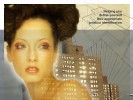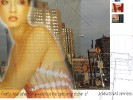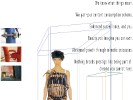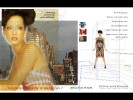Fictive Advertising, 2001
Fictive Advertising – Conversion of periodical literature to product message delivery systems.
Â
A two page magazine spread, presented in NY Arts magazine, created as an artwork intended to critique magazine advertising.
Image Samples:
Download Medium Resolution PDF File:
Â
Project Description:
Business/Economics, Symbol Systems/Myths and Dreams.
“The major media are large corporations, owned by and inter linked with even larger conglomerates. Like other corporations, they sell a product to a market. The market is advertisers – that is, other businesses. The product is audiences for the elite media, relatively privileged audiences. So we have major corporations selling wealthy and privileged audiences to other businesses. Not surprisingly the picture of the world presented reflects the narrow and biased interests of the sellers, the buyers, and the product.” – Noam Chomsky.
Culture jammers have been making fake ads for a while now. They usually involve hacking of a specific ad or campaign. “Subvertising.” Part of the hack is usually to attack a particular brand. With fashion “subvertisements” the most common ones are Calvin Klein and Tommy Hilfiger. Though this is powerful and effective, in some sense it’s like what Naomi Klein, author of “No Logo,” says about attacking corporations. A specific Multinational works as a handle to grab on to or rally against in order to get a point across, but the real problem which needs addressing is the hugely complex structure of global capital and trade agreement formation.
The problem is twofold. Part of the issue is the economics, and part of the issue is the meaning or symbol system. John de Graaf, Thomas Naylor, David Wann in their book “Affluenza: The All-Consuming Epidemic” describe consumerism as “a painful, contagious, socially-transmitted condition of overload, debt, anxiety and waste resulting from the dogged pursuit of more.” Yet people aren’t stupid, so what is going on?
Advertising is an important part of the structure. Its relation to the larger issue of global economic exploitation needs to be understood. In one way it can simply be read as giant corporations trying to poison our thoughts so that we consume endlessly more product. Yet a solely economic analysis of advertising does not get at the whole of the problem. Equally important is its fundamental relation to meaning in our culture. Advertising is amazing. Advertising is beautiful. Advertising uses what we care about, the deep seated and fundamental beliefs and longings in our culture. We have to see that advertising, for better or worse, is carrying a huge part of our cultural canon right now.
In the 1980’s people finally admitted to themselves that the point of businesses is not to provide products or services. The point is to make money. Because money, not service, is the ultimate goal, a bad product or service is just as effective as a good one, or none at all, if it makes money for the corporation. Provision of product or service is tangential to business. The two may happen to be in confluence at times but there is no guarantee or even need for them to be. It’s quite possible that the less of a product you have and the less you pay workers to produce it the more profit you garner.Â
Similarly, advertising is not about a product or service, but rather about getting as many people as possible to consume. It is not the product which is sold but the sense of a lack in the potential consumer. A combination of a dream and a sense that it is as yet unfulfilled – and that consuming will consummate the new hope or dream. People focus on this rather than other types of activity which might be helpful for them, but which might disrupt the status quo. This is the heart of the second part of the problem, the symbol system.
As Andrew Boyd of the culture-jammer mime campaign “Billionaires for Bush (or Gore)” notes “advertising imagery is the ultimate stealth virus. It has long been post or pre rational, operating by subconscious association, by veiled promise and threat, by mobilizing our longings and our dream world. Rational critique can’t find a handle by which to challenge such a worldview.”
Though advertising can seem trivial, it is actually carrying inside it our most prized beliefs. Further, it is one of the main avenues of dissemination for these important cultural concepts. Some of the finest artists in the world work in it, and they receive a great deal of prestige and recognition for doing so. It is in some way similar to shamanistic practice in folk societies. Not that it is arcane or inscrutable but rather that it involves practitioners or technicians who must get at the heart of the collective dreams within a culture and then harness these. The sacred practitioners do it partly for their own ends, but also to move the culture forward in some ideal path they perceive as right, based on their reading of the dreams and traditions.
Fashion, too, can seem frivolous and inconsequential, yet when anthropologists study a culture, the clothes they wear, and the daily things they surround themselves with, tell a tremendous amount about who they are, how they live, what they care about, and how they see their place in the cosmos.
A lot of how we understand the world still comes from myths buried deep in our general culture’s understanding. Advertising works on these myths, within the subconscious symbol system. Brands are little different from Totems. Providing strength, coherence, a path or organizing principle – a community of the like minded. A special society or group, separate from the others, a definition of self.
I don’t think there can be an easy dismissal of advertising, despite its huge negative impact on creating a sustainable future, because its function is so central to our social structure and because it is working directly with our core cultural beliefs. The key is to acknowledge the beauty and at the same time critique the structure.
Rather than spoof a particular brand, “Fictive Advertising” is an attempt to make reference to a host of styles, reflecting the entire genre of advertising. The use of the sexy dresses is an allusion to couture and high end ready to wear. The architecture refers to the anomic landscapes and empty urban environments used to promote hip hop sportswear. The little boxes and multi-section layout come from interior design ad aesthetic, and the wire frame or spot illustration comes out of youth culture alt/skate punk lifestyle looks.
Economic exploitation around the globe causes hate at being oppressed. We are belatedly waking up to this obvious fact. Terror is not justifiable. Ever. Period. We as a culture are not to blame for terror. It is also a poor tactic in that it leads to more oppression. Yet the problem is that human suffering and human rights violations are coming back to haunt us, as normal people in exploited nations choose to support fanatics as the only way they see out of their own oppression. If they were actual participants in the largess of the global economic structure they wouldn’t want to destroy it, as they would be hurting themselves. Instead, we get the hard earned value of their labor, and they are left hopeless and desperate. Meanwhile, we are constantly encouraged to want to get more. All of this economic truth is also hiding behind ads.
Despite the concerted efforts of the World Bank and the WTO, I do not believe there is a Global Conspiracy of Western Corporate Industrialism to destroy the World nor of Advertisers to steal our minds. Rather there is an organic cultural process which we can ignore and allow to occur or which we can recognize, and attempt to alter. The first step in changing anything is to understand it. Like the Wizard of Oz, it may look big and shiny, all-powerful and inscrutable, but it is actually operating with basic processes, with gears and levers that we can grasp.
Kalle Lasn of the venerable ADBUSTERS notes “right now, corporations have the power. They beam their memes into our brains at the rate of a few thousand ads, brand logos and marketing thrusts per day.” and further “Every outburst of cognitive dissonance is useful, but to mount a serious challenge against corporate rule, we jammers must build our own meme factory. Because we have severely limited budgets, our strategies must be perfectly crafted to tear gaps in the glitter of the consumer spectacle.”
Jump in and work the stuff over. Squeeze it a little and see what pops out. Get out the scissors and start shaping. Fictive advertising: Doing our part to tear a few gaps in the glitter. Making some new glitter. Paying a little attention to the man behind the curtain…
Credits:
Conceived and Created by Paul ClayÂ
Layout and design by Paul Clay and Jamie LeoÂ
Fashions: Paul ClayÂ
Styling: Star Studio ProductionsÂ
Photo: Jo Lance www.jolancephoto.comÂ
Make-up: Yukiko Takagi and CadilacÂ
Model: Annalyce
Special thanks:
Abraham Lubelski, Kazue Soma, and everyone at NY Arts Magazine.



